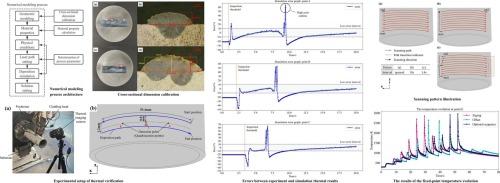Numerical modeling for thermal evaluation of scanning patterns in directed energy deposition of curved surface components
IF 6.8
1区 工程技术
Q1 ENGINEERING, MANUFACTURING
引用次数: 0
Abstract
Directed Energy Deposition (DED) technology can precisely deposit and form metal materials, satisfying the manufacturing requirements of complex curved surface components. Controlling the heat distribution in the deposition area during continuous deposition is crucial to ensure the forming quality. However, previous experimental studies suffered from the problems of high manual cost. In this paper, a numerical modeling method supporting free-path deposition for robot-assisted metal DED processes was developed, which can efficiently and accurately predict the thermal field evolution during the DED manufacturing of curved surface components. The model is built based on real physical scenarios and integrates relevant process parameters, highly restoring the dynamic deposition process of metals. The accuracy of the prediction results was verified by comparing with an infrared thermal image camera on a curved surface component deposition. The study carried out parallel multi-track deposition experiments on cylindrical substrates under three laser scanning patterns, and analyzed the results through the corresponding numerical models. The results show that the established numerical model can provide assistance for evaluating the process strategies of curved surface components DED.

曲面元件定向能沉积扫描模式热评价的数值模拟
定向能沉积(DED)技术可以精确沉积和成形金属材料,满足复杂曲面零件的制造要求。在连续沉积过程中,控制沉积区内的热分布是保证成形质量的关键。但以往的实验研究存在人工成本高的问题。本文提出了一种支持自由路径沉积的机器人辅助金属DED工艺数值模拟方法,该方法可以有效、准确地预测曲面零件DED制造过程中的热场演化。该模型基于真实物理场景建立,整合了相关工艺参数,高度还原了金属的动态沉积过程。通过与红外热像仪在曲面构件沉积上的对比,验证了预测结果的准确性。在三种激光扫描模式下,在圆柱形衬底上进行了平行多径沉积实验,并通过相应的数值模型对实验结果进行了分析。结果表明,所建立的数值模型可为曲面零件DED工艺策略的评价提供帮助。
本文章由计算机程序翻译,如有差异,请以英文原文为准。
求助全文
约1分钟内获得全文
求助全文
来源期刊

Journal of Manufacturing Processes
ENGINEERING, MANUFACTURING-
CiteScore
10.20
自引率
11.30%
发文量
833
审稿时长
50 days
期刊介绍:
The aim of the Journal of Manufacturing Processes (JMP) is to exchange current and future directions of manufacturing processes research, development and implementation, and to publish archival scholarly literature with a view to advancing state-of-the-art manufacturing processes and encouraging innovation for developing new and efficient processes. The journal will also publish from other research communities for rapid communication of innovative new concepts. Special-topic issues on emerging technologies and invited papers will also be published.
 求助内容:
求助内容: 应助结果提醒方式:
应助结果提醒方式:


